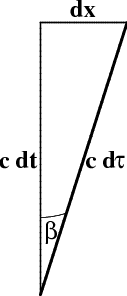- §1. Proper Time
- §2. Energy and Momentum
- §3. Conservation Laws
- §4. Energy
- §5. Useful Formulas
Proper Time
Let $\tau$ denote time as measured by a clock carried by an observer moving at constant speed $u$ with respect to the given frame. We call $\tau$ “wristwatch time” [ 2 ], or, more formally, proper time. Such a clock simply measures the “length” of the observer's worldline. But this length can be measured in any reference frame.
The (infinitesimal) geometry of this situation is shown in Figure 9.1. Since $d\tau$ is the length of the hypotenuse, it follows immediately that \begin{equation} d\tau = \frac{1}{\cosh\alpha} \> dt \end{equation}
Equivalently, since the position of the moving observer doesn't change in the moving observer's own rest frame, we have from the invariance of the interval that \begin{equation} dx^2 - \csq dt^2 = 0 - \csq d\tau^2 \end{equation} so that \begin{equation} d\tau^2 = \left( 1-\cmsq\left(\frac{dx}{dt}\right)^2 \right) dt^2 \end{equation} or equivalently \begin{equation} d\tau = \sqrt{1-\uucsq} \> dt = \frac{1}{\gamma} \> dt = \frac{1}{\cosh\alpha} \> dt \end{equation}
This computation yields the same answer (for $\tau$, not for $t$) in any reference frame; proper time is independent of reference frame!
